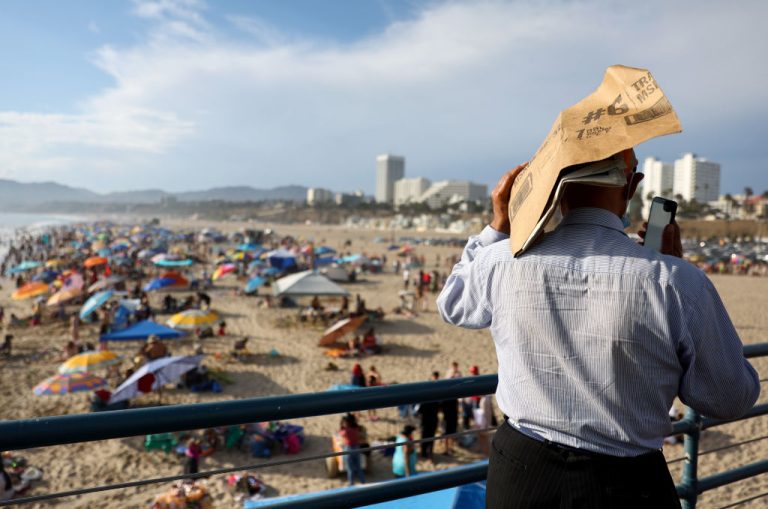As the State of California bakes in a historic heatwave, the power grid operator has called on citizens and businesses for days to reduce consumption so as to avert potential blackouts.
Despite the request, the state nonetheless posted a new all time record for peak energy consumption on Sept. 6, dwarfing Canada’s record by a factor of almost two.
As a result, tens of thousands of California homes lost electricity service.
The day marked one where the California Independent Systems Operator (California ISO) warned in a News Release that blackouts are imminent in order to protect the grid.
California ISO issued an Energy Emergency Alert Level 3 “as electricity supplies run low in the face of record heat and demand.”
MORE ON THE SHORTCOMINGS OF RENEWABLE ENERGY
- Forget Crickets. Soon, You’ll Eat Recycled Wind Turbines
- Amid Record Heatwave, Europe Discovers Solar Panels Inefficient in High Temperatures
- After Electric Bus Burns to Ashes, Connecticut Replaces Fleet With Diesel
- Worn-down Wind Turbines Headed to Landfills Because Recycling Is Too Expensive: Study
Success
You are now signed up for our newsletter
Success
Check your email to complete sign up
“If necessary, the grid operator can now order rotating power outages to lower demand and stabilize the system,” the release warned.
On Sept. 1, Vision Times reported that California Governor Gavin Newsome had already declared a State of Emergency over the energy crisis as California ISO had issued both the more minor Flex Alert Watch and an Energy Emergency Alert Level 1 in attempts to get the public to curtail air conditioning usage and electric vehicle charging.
A Fact Sheet for the operator’s Emergency Notification levels defines an EEA Level 3 as a situation dire enough that the “ISO is unable to meet minimum Contingency Reserve requirements and controlled power curtailments are imminent or in progress according to each utility’s emergency plan.”
The Level 3 declaration also stated that although a Level 2 Alert had been issued only hours prior, “As grid conditions worsened, energy supplies were determined to be insufficient to cover demand and reserves, and an EEA 3 was declared.”
On Twitter the same evening, California ISO announced that peak demand clocked a new all time high at 52,061 megawatts.
The number is exceptionally significant. A Peak Load History fact sheet dating back to 1998 issued by the operator shows that the peak load recorded throughout all of 2021 was a comparatively tame 43,982 megawatts logged on Sept. 8.
The highest on record prior to today was 50,270 megawatts posted in 2006.
To put the figure into perspective, according to Canada’s Independent Electrical Systems Operator, the all-time high peak demand recorded for the entire country was 27,005 megawatts set in the summer of 2006.
Just a day earlier on Sept. 5, Elliot Manzer, President and CEO of California ISO, stated in a Press Release that although the grid had “seen a positive impact on lowering demand because of everyone’s help,” the situation had grown so dire that “now we need a reduction in energy use that is two or three times greater than what we’ve seen so far as this historic heat wave continues to intensify.”
In a Sept. 4 Press Release, Manzer stated that the forecast for peak demand was significantly lower at only 48,817 megawatts.
Despite the contrastingly positive figure, however, he noted that the grid was already facing a shortfall as high as 4,000 megawatts.
A 2012 explainer posted by the United States Nuclear Regulatory Committee (NRC) debunks the myth that a megawatt powers roughly 1,000 houses, stating instead, “For conventional generators, such as a coal plant, a megawatt of capacity will produce electricity that equates to about the same amount of electricity consumed by 400 to 900 homes in a year.”
The NRC adds, “For renewable energy such as wind or solar, the equivalent is even less because they typically produce less energy than conventional generators since their fuel source is intermittent.”
And blackouts have indeed been endured. According to data aggregator PowerOutage.us, as of time of writing, more than 60,000 Californians were without electricity, with more than 47,500 of that figure under the PG&E provider.
California is the only state in America suffering from power outages at the moment, the website showed.
So just how bad is the weather in California? According to Sept. 5 reporting by San Francisco Chronicle, the City of Livermore, home to more than 90,000 people, set a Bay Area record at 116 F (46.6 C).
Other cities, such as Fairfield and Oakland, posted numbers as high as 116 and 100, huge figures compared to their previous highs of 108 and 95 set in 1950 and 2008 respectively.
A second article on local conditions stated that one swimming pool, which had marketed itself “as a cooling center Saturday through Tuesday from 11 am to 6 pm for those needing to escape the heat,” suddenly decided to shutter, issuing a statement declaring the reason as “due to the excessive heat forecasted.”
















